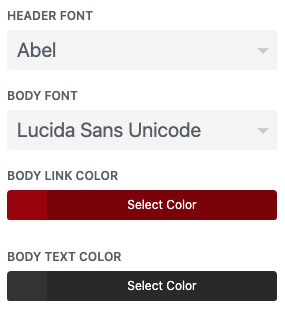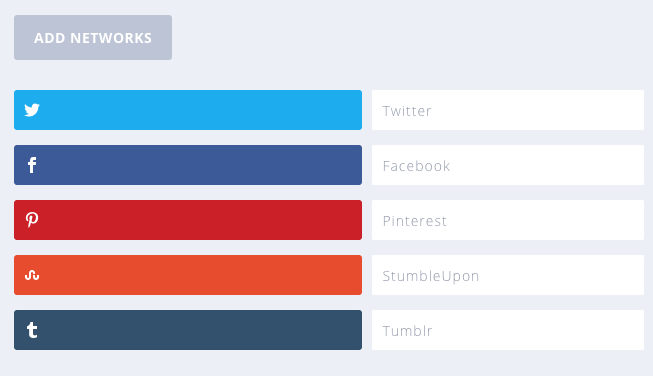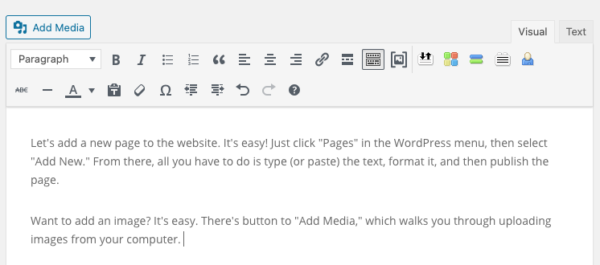WordPress is technically called a content management system, but it’s best understood as website software. You use Microsoft Word to make documents. We use WordPress to make websites. WordPress is a flexible and agile platform with tons of benefits for small business websites. Because it’s open source, there are tons of add-ons (free and premium) that can enhance the features, functionality, and design of any WordPress website. It’s widely used, which means there is an abundance of help available, from WordPress designers and developers to tutorials that can teach you anything and everything about how to use it.
Best of all, WordPress is extremely easy to use, especially once a website is up and running. I often work together with my clients on their websites. They add and change content, and I manage the tech and design aspects.
Let’s take a look at how you can make your own changes to your WordPress website.
Design
As a content management system, it’s best to think of WordPress as a bunch of containers that hold your content: text, images, videos, etc. The design of your website is generated by a theme that you install on WordPress. A theme is a collection of files that tell a web browser how to display the content. This is a simplistic explanation of how it works, but it conveys the general idea.
The theme says, put the logo at the top of every page, right next to this menu of links to the main pages on the site. Make the background this color. Use this font for the text, and make it that color. But make links this other color.
Every theme is different. Some themes are free. Others require a (paid) license. All of them can be customized. Some customization must be done via code. But some themes add options to the WordPress dashboard, where you control some design elements by configuring them. You can see an example of font configuration options in a premium theme in the image to the left. In this theme, you can select fonts and colors from simple drop-down menus. Most themes require a mix of both code and configuration to get a good, custom design.
So, depending on your theme, you might be able to make minor changes to your website design without knowing any code. If you want to be able to adjust certain design elements, you should work with your website designer during development to choose a theme with the options that you want.
Features and Functionality (Plugins)
WordPress is pretty bare bones when it comes to features and functionality, which is one of its strengths. You start with a simple but strong structure, and then you add only the features and functionality that you need. This keeps your website agile and efficient.
Plugins are best understood as add-ons or apps that you install on the WordPress platform to enhance your website. It’s important to note here that some themes also come with features and functionality. For example, a common plugin would generate a form on a contact page. Visitors fill out the form to send you a message so you don’t have to publish your email address (this helps cut back on spam and junk mail). But some themes also come bundled with forms, in which case you don’t need the plugin.
Most WordPress websites are customized by a designer and use high-level plugins that require some technical knowledge. For example, I use a theme that comes bundled with form functionality, but I need to install a particular plugin that connects the form to email, which enables it to send messages through my clients’ email system. This is an example of an element that most business owners wouldn’t use in the management of their own websites.
But there are plenty of plugins that are easy for laypersons to use.
The image above depicts the settings for a social-media sharing plugin. It’s pretty simple — you select and arrange the social media platforms that you want your visitors to be able to share your content to, and the plugin then places buttons on your web pages, making it fast and easy for people to share your content across various platforms.
There are hundreds of plugins that can enhance your website’s functionality. You can use plugins to collect email addresses for your mailing list, to manage spammy comments on your blog posts, to edit images that you’ve uploaded, and much more.
Adding and Changing Content: Text and Images
In reality, most small business owners are not interested in making adjustments to the design and functionality of their websites. That’s generally the work of website designers and administrators. In most cases, it’s work best left to the professionals. But many entrepreneurs want to be able to add and change important content on their websites.
for example, let’s say you’re launching a new service and want to add a page to your website. You’ve written the text, and you’ve got a couple of graphics you want to include. Or maybe you were looking at your website and noticed a typo, or realized that a price was out of date. Perhaps your website has a blog, and you want to save some money by uploading and publishing the blog posts yourself. These are all things that anyone can learn to do fairly quickly on a WordPress website. In fact, it’s a lot like using a word processor (like Microsoft Word) or web-based email.
As you can see from the image above, adding content to pages and posts is a breeze on WordPress. If you’ve ever used Microsoft Word, then this panel will look familiar to you. There are standard text formatting options. You can save your work as a draft or publish it (don’t forget to add it to the menu!). You can even schedule it to publish at a future time.
Managing Your WordPress Website
Of course, there’s a lot more to managing your WordPress website. You should make regular backups and keep all your software updated. You should keep an eye on its performance. Depending on how complex your website is, you might want to hire someone to do everything for you. You might want to do it all yourself. Or you might prefer a hybrid solution. For example, I’ve provided website maintenance for clients who want me to handle all the technical maintenance and design tasks, but they regularly add their own blog posts, complete with images.
Some aspects of managing your own WordPress website are so easy as to be intuitive if you’re already a little tech-savvy. Other elements can be learned with a few tutorials that you can find online. I’ve provided coaching to clients who wanted to learn more advanced features of WordPress with custom tutorials that I’ve created for them coupled with one-on-one consults to answer questions and provide tips and guidance.
These days, there are tons of options when it comes to choosing a website platform. It’s an important decision for any small business owner to make. Once you go through the effort of building a website, you don’t want to find out that you’ve chosen the wrong the platform. WordPress is not necessarily ideal for every business — I usually recommend other platforms for e-commerce sites — but the benefits of WordPress are vast indeed.
Buzz Pro Studio provides website services to small businesses and independent professionals, specializing in website design and maintenance. For more information or to get a no-obligation quote, contact me.
Melissa Donovan is the founder of Buzz Pro Studio, providing website services to small businesses and independent professionals.





